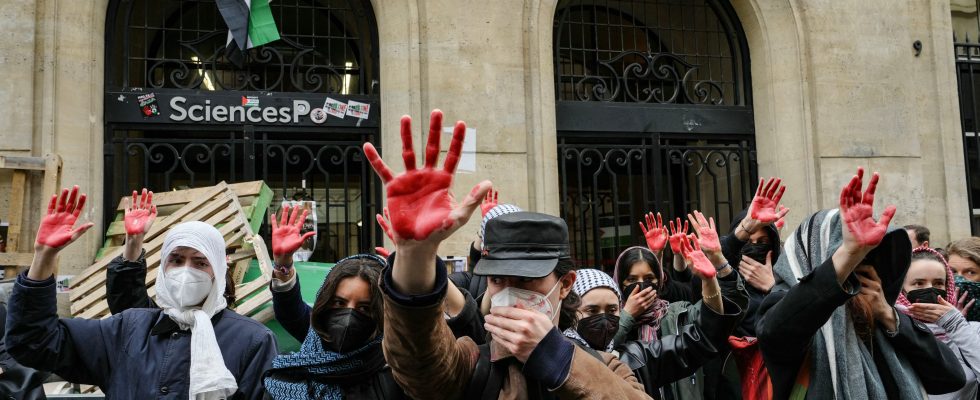In the wake of American campuses, pro-Palestinian students gathered in front of Sciences Po Paris on rue Saint-Guillaume this Thursday, April 25. With cries of “Israel a murderer” and “everyone hates the police”, the crowd displays Palestinian flags and calls for the liberation of Gaza. The next day, do it again. Activists respond to the call for “uprising”, launched by Rima Hassan on X (formerly Twitter) Friday morning. Unsurprisingly, the arrival of the candidate Insoumise in the European elections mobilizes people. Under the gaze of the cameras, hundreds of young people join the sit-in.
But at the end of these two days of high tension, one image particularly caught our attention: a photograph in which young people raise their hands, covered in red paint. Quickly, the amateur photo is taken up, shared, commented on. Thousands of accounts broadcast a montage which superimposes the photo captured around the Parisian faculty with another, taken in Ramallah on October 12, 2000 which shows an individual raising his red hands to the sky. But unlike the Parisian students, his hands are not covered in red paint, but in blood. That of the two Israeli reservists whom he has just murdered, and whose bodies he will throw into the crowd a few minutes later. At the end of the day, Friday, while activists are still blocking the establishment, Renaissance MP Maud Bregeon denounces on BFMTV “slogans and symbols which flirt with anti-Zionism and anti-Semitism”.
Universal symbol or anti-Zionist reference?
The next day, the controversy continued. On his X account, Raphaël Enthoven publishes a message “for the uneducated”. For the philosopher, the symbol of red hands is anything but a call for a ceasefire. This is a “direct reference to the massacre of two Israelis by the population of Ramallah,” he insists. And to attach to its publication a drawing by Joann Sfar which recounts the bloody day of October 12, 2000. “Two Israelis were massacred with their bare hands by the population of Ramallah. The bodies of Yosef Avrahami and Vadim Norznich will be dismembered, hanged and burned Before being dragged joyfully to the center of the city, their executioners telephoned their parents laughing,” recalls the Nice illustrator and author of numerous comic strips, who confirms: “Wearing this symbol today. It’s a call for massacre.”
Immediately, pro-Palestinian activists and Insoumis executives responded, denying any reference to the massacre of October 12, 2000. To defend themselves, those concerned were not short of arguments. The first of these is to argue that it is a universal allegory denouncing those whose “hands are covered in blood”. “This symbol is regularly used in demonstrations in the West, and at the UN,” argues to L’Express, Hubert Launois, student at Sciences Po Paris and member of the Palestine Committee.
Several support accounts notably refer to other movements that have used the “red hands” symbol. The Black Lives Matter demonstrations for example, or the Friends of the Earth collective in February 2022. On October 31, Rima Hassan published a photo which, according to her, “will be a landmark”. That of a hearing in Congress concerning American aid to Israel three weeks after the massacre of October 7. In the background, protesters raise their hands covered in red paint. Way to “denounce the genocide underway in Gaza”, wrote the activist of Palestinian origin. A publication which, at the time, did not cause any uproar.
Which leads us to the second argument: Israeli families also used this symbol on the occasion of the 200 days of captivity of the hostages. “What’s under your hair is called a brain and it’s made to be used,” exclaims the head of France insoumise Manuel Bompard in the publication of Pernelle Richardot. The PS European MP was one of the first to see in the April 26 sequence a reference to the massacre committed in Ramallah 24 years earlier.
Ignorance or anti-Semitism?
The third argument consists of pleading ignorance. The activists present at the demonstration, many born in the 21st century, would not have heard of the assassinations of October 12, 2000. At L’Express, Hubert Launois assures us: “It is not an image that speaks to our generation, we only had the reference of the red hands used in dozens of demonstrations”. The student denounces in particular the “instrumentalization” on the part of the pro-Israeli camp. “We attribute anti-Semitic intentions behind a known symbol, it is part of the dynamic of criminalization of the action of activists who are committed to the Palestinians,” believes Hubert Launois.
But on her Instagram account, Joann Sfarr persists and signs: “Red hands are a dogwhistle (foot call, Editor’s note) […] if you use it, consciously or not, you are not calling for peace, but for a pogrom.” For his part, Raphaël Enthoven crushes “the manipulators who know the reference perfectly, whose goal is to produce ambiguous images” .
More broadly, it is the pro-Palestinian character of the mobilization which questions the choice of symbol. Displaying red hands in a demonstration aimed at denouncing femicide would not have the same impact as in a demonstration linked to the Israeli-Palestinian conflict. “I don’t know a single Israeli or Palestinian who, faced with these red hands, does not think of the lynching of 2000,” underlines Joann Sfarr in particular.
Universal symbol for some. Incitement to massacre for others. This controversy leads to questions. Is displaying an emblem without knowing its meaning simply clumsy or does it represent a fantastic opportunity to play on ambiguity? On social networks, on television sets, in radio studios, two camps have been clashing since Friday. The same two who have been facing each other and fighting each other since October 7, 2023.
